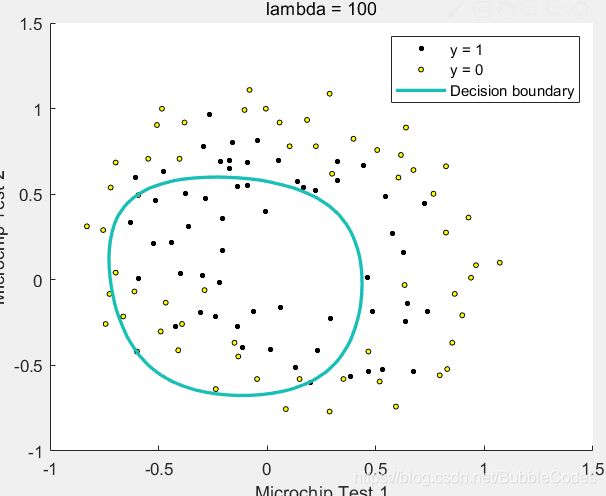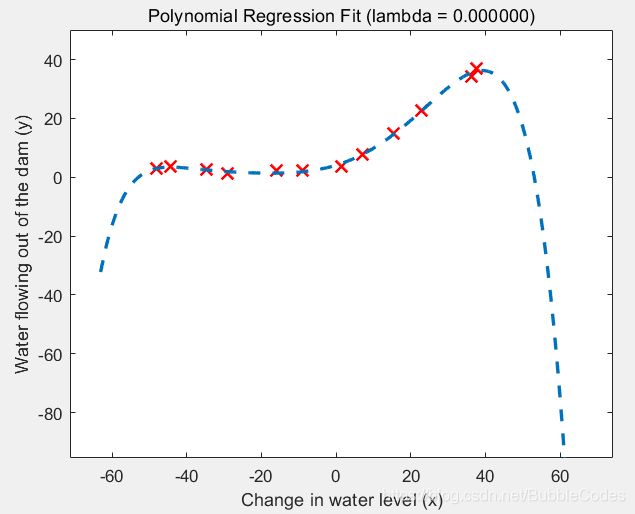吴恩达-机器学习系列课程-Matlab作业
吴恩达-机器学习系列课程-Matlab作业
- ex1 Linear Regression
-
- warmUpExercise.m
- plotData.m
- computeCost
- gradientDescent
- feature normalization
- computeCostMulti
- gradientDescentMulti
- normalEqn
- ex2 Logistic Regression
-
- plotData
- sigmoid
- costFunction
- predict
- costFunctionReg
- ex3 Multi-class Classification and Neural Networks
-
- LrCostFunction
- oneVsAll
- predictOneVsAll
- predict
- ex4 Neural network learning
-
- nnCostFunction(Feedforward and cost function)
- nnCostFunction (Regularized cost function)
- sigmoidGradient
- randInitializeWeights(Random initialization)
- nnCostFunction(Backpropagation)
- ex5 Regularized Linear Regression and Bias v.s. Variance
-
- linearRegCostFunction
- learningCurve
- polyFeatures
- validationCurve
- ex6 Support Vector Machines
-
- gaussianKerne
- dataset3Params
- processEmail
- emailFeatures
- ex7 K-means Clustering and Principal Component
-
- findClosestCentroids
- computeCentroids
- pca(Principle Component Analysis)
- recoverData
- ex8 Anomaly Detection and Recommender Systems
-
- estimateGaussian
- selectThreshold
- cofiCostFunc
欢迎批评指正
ex1 Linear Regression
warmUpExercise.m
A=eye(5);
plotData.m
figure; % open a new figure window
plot(x, y, 'rx', 'MarkerSize', 10); % Plot the data
ylabel('Profit in $10,000s'); % Set the y-axis label
xlabel('Population of City in 10,000s'); % Set the x-axis label
r:red
x:x-shapped point
MarkerSize:point size
结果:

computeCost
h = X*theta;
J = 1/(2*m)*sum((h-y).^2);
实数矩阵转置:'
矩阵每个元素平方:.^
gradientDescent
h = X*theta;
theta = theta-alpha/m*X'*(h-y);
% theta has two vars, X doesnt have to only take secth col
feature normalization
mu = mean(X, 1);
sigma = std(X, 0, 1);
for i = 1:size(X, 2)
X_norm(:,i) = (X_norm(:,i)-mu(1, i))/sigma(1, i);
end
%mean(X, 1/2) return X matrix cols/rows mean
%std(X, 0/1, 1/2) return X matrix cols/rows 标准差
%0 stand for n-1
%1 stand for n
% X_norm(:,i)-mu(1, i) work for all rows
computeCostMulti
h = X*theta;
J = 1/(2*m)*sum((h-y).^2);
%computCost still work here
gradientDescentMulti
h = X*theta;
theta = theta - alpha/m*((h-y)'*X)';
normalEqn
theta = pinv(X' * X) * X' * y;
% pinv return inverse of a matrix
ex2 Logistic Regression
plotData
% Find Indices of Positive and Negative Examples
pos = find(y==1); neg = find(y == 0);
% Plot Examples
plot(X(pos, 1), X(pos, 2), 'k+','LineWidth', 2, 'MarkerSize', 3);
plot(X(neg, 1), X(neg, 2), 'ko', 'MarkerFaceColor', 'y', 'MarkerSize', 3);
%find:return the index of element(according to the col)
sigmoid
g = 1./(1+exp(-z));
% 1/[1, 2] == error
% 1./[1, 2] == [1, 0.5]
% f=@(h) 1 ./ (1 + exp(-h)); % 1 / (1 + exp(-h));
% g = f(z);
costFunction
h = sigmoid(X*theta);
J = 1/m*(-y'*log(h)-(1-y')*log(1-h));
grad = 1/m*X'*(h - y);
predict
p = round(sigmoid(X*theta));
% round: return the closest integer
% p is the predict, not the probablity
costFunctionReg
h =sigmoid(X*theta);
theta_1=[0;theta(2:end)]; % theta_0不需要正则化
J = 1/m*(-y'*log(h)-(1-y')*log(1-h))+lambda/(2*m)*sum(theta_1.^2);
grad = 1/m*X'*(h - y) + lambda/m*theta_1;
ex3 Multi-class Classification and Neural Networks
LrCostFunction
h = sigmoid(X*theta);
thetaZero = theta;
thetaZero(1) = 0;
J = 1/m*(-y'*log(h)-(1-y)'*log(1-h))+lambda/(2*m)*sum(thetaZero.^2);
grad = 1/m*X'*(h-y)+lambda/m*thetaZero;
% theta(1) = theta_0, who doesnt need to regularization
结果:
oneVsAll
% Set Initial theta
initial_theta = zeros(size(all_theta, 2), 1);
% set options for fminunc
options = optimset('GradObj', 'on', 'MaxIter', 50);
% iterat 50
for i = 1 : num_labels
theta = fmincg(@(t)(lrCostFunction(t, X, (y==i), lambda)), initial_theta, options);
all_theta(i,:) = theta;
end
% y==i has the same size with y
predictOneVsAll
h = all_theta*X';
[max_val, max_index] = max(h, [], 1);
p = max_index';
% 1 represents the output is 1*n
% 2represents the output is n*1
predict
%
for i = 1:m
X_1 = [1 X(i, :)];
Z1 = Theta1*X_1';
A1 = sigmoid(Z1);
A1 = [1 A1'];
Z2 = Theta2*A1';
A2 = sigmoid(Z2);
[max_val ,p(i)] = max(A2);
end
ex4 Neural network learning
nnCostFunction(Feedforward and cost function)
%recode y
y1 = zeros(num_labels, m);
for i = 1:m
y1(y(i), i) = 1;
end
%1th layer
A1 = [ones(size(X, 1), 1) X];
%2th layer
Z2 = Theta1*A1';
A2 = sigmoid(Z2);
A2 = [ones(1, size(A2, 2)); A2];
%3th layer
Z3 = Theta2*A2;
A3 = sigmoid(Z3); %K*m
J = 1/m*sum(sum(-log(A3).*y1-log(1-A3).*(1-y1)));
% nots:
%we get the prediction A3 which is a K*m matrix
%each col is the prediction of each classifier
%so we need to recode y to get each cost of each classifier of every example.
%now, we only get the costFunction J not dJ/dθ
nnCostFunction (Regularized cost function)
%recode y
y1 = zeros(num_labels, m);
for i = 1:m
y1(y(i), i) = 1;
end
%1th layer
A1 = [ones(size(X, 1), 1) X];
%2th layer
Z2 = Theta1*A1';
A2 = sigmoid(Z2);
A2 = [ones(1, size(A2, 2)); A2];
%3th layer
Z3 = Theta2*A2;
A3 = sigmoid(Z3); %K*m
%unregularizatied
J = 1/m*sum(sum(-log(A3).*y1-log(1-A3).*(1-y1)));
%regularization
regPart = lambda/(2*m)*(sum(sum(Theta1(:, 2:size(Theta1, 2)).^2)) + sum(sum(Theta2(:, 2:size(Theta2, 2)).^2)));
J = J+regPart;
%note:
%??Theta1/2(0) for each classifier are not in regularization part.
sigmoidGradient
g = sigmoid(z).*(1-sigmoid(z));
%mind the .*
randInitializeWeights(Random initialization)
%Randomly initialize the weights to small values
epsilon_init = 0.12;
W = rand(L_out, 1 + L_in) * 2 * epsilon_init - epsilon_init;
% rand(x, y) returns a x*y matrix which follows Uniform distribution
无结果
nnCostFunction(Backpropagation)
%--------------------------------------------------
%forward propagation
%recode y
y1 = zeros(num_labels, m);
for i = 1:m
y1(y(i), i) = 1;
end
%1th layer
A1 = [ones(size(X, 1), 1) X];%m*(layer1_size+1)
A1 = A1';%(layer1_size+1*m)
%2th layer
Z2 = Theta1*A1;
A2 = sigmoid(Z2);
A2 = [ones(1, size(A2, 2)); A2];
%3th layer
Z3 = Theta2*A2;
A3 = sigmoid(Z3); %K*m
%unregularizatied
J = 1/m*sum(sum(-log(A3).*y1-log(1-A3).*(1-y1)));
%regularization
regPart = lambda/(2*m)*(sum(sum(Theta1(:, 2:size(Theta1, 2)).^2)) + sum(sum(Theta2(:, 2:size(Theta2, 2)).^2)));
J = J+regPart;
%-----------------------------------------------------------------------
%backpropagation
%size(X) = m*1thLayer
%size(a1) = 1thLayer*m
X = X';
for i = 1:m
%1th layer
%size(a1) = lthLayer*1
a1 = X(:, i);
%2th layer
%size(Theta1) = 2thLayer*(1thLayer+1)
%size(a2) = size(z2) = 2thLayer*1
z2 = Theta1*[1; a1];
a2 = sigmoid(z2);
%3th layer
%size(Theta2) = 3thLayer*(2thLayer+1)
%size(a3) = 3thLayer*1
z3 = Theta2*[1;a2];
a3 = sigmoid(z3);
%error back propagation
%there is no delta1
%size(delta3) = 3thLayer*1
%size(delta2) = 2thLayer*1
%size(Theta2) = 3thLayer*(2thLayer+1)
delta3 = a3-y1(:, i);
delta2 = Theta2(:, 2:size(Theta2,2))'*delta3.*sigmoidGradient(z2);
%size(Theta2_grad) = size(Theta2) = 3thLayer*(2thLayer+1)
%size(Theta1_grad) = size(Theta1) = 2thLayer*(1thLayer+1)
%size(delta3) = 3thLayer*1
%size(delta2) = 2thLayer*1
%size(a2) = 2thLayer*1
%size(a1) = 1thLayer*1
Theta2_grad = Theta2_grad + delta3 * ([1; a2]');
Theta1_grad = Theta1_grad + delta2 * ([1; a1]');
end
%size(Theta2_grad) = size(Theta2) = 3thLayer*(2thLayer+1)
%size(Theta1_grad) = size(Theta1) = 2thLayer*(1thLayer+1)
Theta1_grad(:, 1) = Theta1_grad(:, 1)./m;
Theta2_grad(:, 1) = Theta2_grad(:, 1)./m;
Theta1_grad(:, 2:end) = Theta1_grad(:, 2:end)./m+lambda/m.*Theta1(:, 2:end);
Theta2_grad(:, 2:end) = Theta2_grad(:, 2:end)./m+lambda/m.*Theta2(:, 2:end);
结果:
ex5 Regularized Linear Regression and Bias v.s. Variance
linearRegCostFunction
h = X*theta;
J = 1/(2*m)*sum((h-y).^2)+lambda*sum(theta(2:end, :).^2)/(2*m);
grad = 1/m*X'*(h-y)+lambda/m*[0;theta(2:end, :)];
learningCurve
for i = 1:m
theta_i = trainLinearReg(X(1:i, :), y(1:i, 1), lambda);
[error_train(i, 1), grad_train] = linearRegCostFunction(X(1:i, :), y(1:i, 1), theta_i, 0);
[error_val(i, 1), grad_val] = linearRegCostFunction(Xval, yval, theta_i, 0);
end
% need to notice:
% 1:when computing the error, lambda = 0, which means that no regularization term in error.
% 2:when computing the error_val, you need count all the cross validation set in
%high bias problem exits
polyFeatures
for i = 1:p
X_poly(:, i) = X(:, 1).^i;
end
%low bias
%high variance. There is a gap between the training and cross validation errors, indicating a high variance problem.
%解决方法是引入regularization
validationCurve
for i = 1:length(lambda_vec)
theta = trainLinearReg(X, y, lambda_vec(i));
[error_train(i), grad_train] = linearRegCostFunction(X, y, theta, #pic_center);
[error_val(i), grad_val] = linearRegCostFunction(Xval, yval, theta, 0);
end
% visualize the effect of lambda
ex6 Support Vector Machines
gaussianKerne
sim = exp(-sum((x1-x2).^2)/(2*sigma^2));
dataset3Params
testValues = [0.01, 0.03, 0.1, 0.3, 1, 3, 10, 30];
results = [];
for loopC = 1:length(testValues)
for loopSigma = 1:length(testValues)
testC = testValues(loopC);
testSigma = testValues(loopSigma);
model= svmTrain(X, y, testC, @(x1, x2) gaussianKernel(x1, x2, testSigma));
predictions = svmPredict(model, Xval);
testError = mean(double(predictions ~= yval));
fprintf("C: %f\nsigma: %f\nerror: %f\n", testC, testSigma, testError);
results = [results; testC, testSigma, testError];
end
end
[minError, minIndex] = min(results(:,3));
C = results(minIndex,1);
sigma = results(minIndex,2);
fprintf("\n\nLeast error:\nC: %f\nsigma: %f\nerror: %f\n", C, sigma, minError);
%关于~=在矩阵中的应用:
%其相当于≠
%作用与两个相同size的矩阵时,对应位置相等的地方填逻辑0,不相等的地方填逻辑1
processEmail
% find(判断):返回满足条件的元素下标
%ismember判断是否为其元素
word_indices = [word_indices; find(ismember(vocabList, str))];
emailFeatures
x(word_indices)=1;
%X向量与vocabList向量维度大小一致
%letter中出现了某单词,即将X向量对应位置置一
ex7 K-means Clustering and Principal Component
Analysis
findClosestCentroids
for i = 1:size(X, 1)
distances = sum((X(i, :).*ones(size(centroids)) - centroids).^2, 2);
[minValues, idx(i)] = min(distances, [], 1);
end
% 对每个样本,计算其到每个聚类中心的距离
computeCentroids
for i = 1:K
rowIndex = find(idx == i);
if size(rowIndex, 1) > 0
centroids(i, :) = 1/length(rowIndex) * sum(X(rowIndex, :) , 1);
end
end
% need to judge whether there is miu_k that has samples attributed
pca(Principle Component Analysis)
% computing the covariance matrix of data X
sigma_capital = 1/m .* X'*X;
% computing the eigenvector of sigma_capital
% where U will contain the principal components and S will contain a diagonal matrix
[U, S, V] = svd(sigma_capital);
% U is n*n, U_reduce is n*K
U_reduce = U(:, 1:K);
% Computing the projection of each sample on each vector*K(1*n)
Z = X*U_reduce;
recoverData
% why?
U_reduce = U(:, 1:K);
X_rec = Z*U_reduce';
ex8 Anomaly Detection and Recommender Systems
estimateGaussian
mu = mean(X, 1);
sigma2 = var(X, 0, 1);
selectThreshold
% caculate truePostive, falsePostive, falseNegtiive
% & used between matrix, && used between scalar. same with | and ||
tp = length(nonzeros((pval < epsilon) & (yval == 1)));
fp = length(nonzeros((pval < epsilon) & (yval == 0)));
fn = length(nonzeros((pval > epsilon) & (yval == 1)));
% caculate the precsion, recall, F1
prec = tp/(tp+fp);
rec = tp/(tp+fn);
F1 = 2*prec*rec/(prec+rec);
cofiCostFunc
% regularization term
J = 1/2 * sum( ( (X * Theta' - Y).*(R==1) ).^2 , 'all') + lambda/2*sum(sum(X.^2)) + lambda/2*sum(sum(Theta.^2));
% gradient term without regularized
X_grad = (X * Theta' - Y) .* (R==1) * Theta;
Theta_grad = ((X * Theta' - Y).*(R==1))' * X;
% regularization term
% X_grad is nm*n
% Theta_grad is nu*n
X_grad = X_grad + lambda.*X;
Theta_grad = Theta_grad + lambda.*Theta;


































